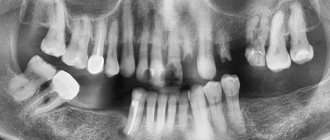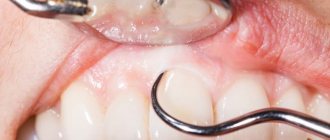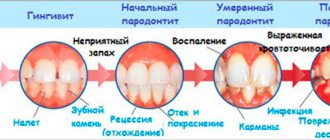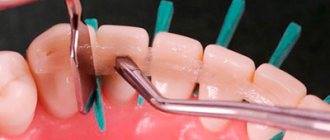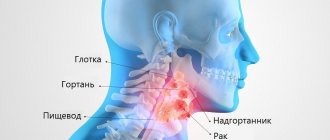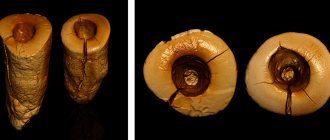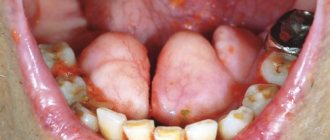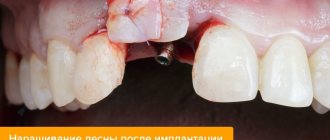What is localized periodontitis?
Localized, or focal, periodontitis is an inflammation of the periodontal tissues surrounding the tooth. Unlike generalized periodontitis, localized periodontitis spreads locally - it affects only one or several adjacent teeth. And even with prolonged development, the disease does not affect the “neighbors”. The disease affects all age groups, regardless of gender, but people aged 30 to 50 years and adolescents are more likely to suffer.
What is generalized periodontitis
Diffuse damage to periodontal tissue is called periodontitis. The generalized form of the disease affects most of the teeth in the oral cavity. The pathology is characterized by the development of an acute or chronic inflammatory process, destruction of soft tissue, and atrophy of the bone of the alveolar process of the jaw.
The leading role in the development of the disease belongs to pathogenic microflora that accumulates in dental plaque, periodontal pockets and on the roots of teeth. In the absence of treatment, the periodontal junction is disrupted, the ligamentous apparatus is destroyed, pathological mobility of teeth occurs and overload occurs when chewing individual parts of the jaw. In advanced stages of the disease, incisor teeth fall out and the patient’s general well-being suffers.
The presence of a constant infectious process in the oral cavity increases the risk of developing rheumatoid arthritis, atherosclerosis, stroke, and myocardial infarction.
Types of Localized Periodontitis
By severity:
- localized periodontitis of mild severity is characterized by pain in some teeth when pressing on the gums, sometimes bleeding and the appearance of periodontal pockets, but the patient’s general well-being does not change;
- localized periodontitis of moderate severity is determined by deepening of the gum pockets, poor tooth mobility, and regular bleeding of the gums;
- localized periodontitis in a severe stage leads to complete loosening of the teeth, exposure of the roots and suppuration of the gums; the bone is so destroyed that implantation without prior extension is no longer possible.
According to the nature of the pathology:
- acute localized periodontitis develops quickly and rapidly, with the manifestation of all the characteristic symptoms - the disease is successfully treated, but without dental care it becomes chronic;
- localized chronic periodontitis is characterized by moments of exacerbation and calm; it seems to the patient that the pathology has receded, but the inflammatory process continues to destroy tissue and manifests itself in a severe stage.
Periodontitis
Introduction
In our country, we use the terminology and classification of periodontal diseases approved at the XVI Plenum of the All-Union Society of Dentists.
Periodontitis is an inflammation of periodontal tissues, characterized by progressive destruction of the periodontium and bone of the alveolar process of the jaws.
Gravity:
light, medium, heavy.
Flow:
acute, chronic, exacerbation, abscess, remission.
Prevalence:
localized, generalized.
Periodontitis is an inflammation of periodontal tissues, characterized by destruction of the periodontal ligaments and alveolar bone.
Flow:
chronic, aggressive.
Process phases:
exacerbation, remission.
The severity is determined
according to the clinical and radiological picture. Its main criterion is the degree of destruction of the bone tissue of the alveolar process (in practice, it is determined by the depth of periodontal pockets/PC/mm).
Severity:
light (PC no more than 4 mm), medium (PC 4-6 mm), heavy (PC more than 6 mm).
Process prevalence:
localized, generalized.
The commission considered it necessary to identify an independent group of periodontal diseases - aggressive forms of periodontitis (prepubertal, juvenile, rapidly progressing. The latter develops in individuals aged 17 to 35 years).
Chronic generalized periodontitis
mild severity
It develops as a complication of untreated chronic catarrhal gingivitis and is characterized by progressive destruction of periodontal tissue and bone of the alveolar processes of the jaws.
Clinic:
It is characterized by an almost complete absence of unpleasant subjective sensations in the patient, hence the low demand for medical help at this stage of the disease. Patients, as a rule, note slight itching in the gums and bleeding due to mechanical irritation (when brushing teeth, eating hard foods). The general condition is not disturbed, although an in-depth, targeted examination usually reveals changes in the immune system, deviations from other organs and systems, pathogenetically associated with periodontal pathology. From the anamnesis it should be clear that the disease began gradually and was practically asymptomatic for a long time.
An objective examination reveals chronically mild inflammation of the gums (swelling, bleeding, hyperemia). Supra- and subgingival dental deposits (mineralized and non-mineralized) are detected. The teeth are motionless and not displaced.
Diagnostic criteria
are: the presence of periodontal pockets up to 3.5 mm deep, mainly in the area of interdental spaces, and the initial degree of destruction of the bone tissue of the alveolar process (x-ray picture: absence of a compact plate at the apexes of the interalveolar septa, foci of osteoporosis, expansion of the periodontal gap in the cervical region).
To make a diagnosis
in this case, it is enough to question the patient, examine the oral cavity, probe clinical pockets, assess tooth mobility, conduct the Schiller-Pisarev test, as well as indication and quantitative assessment of “dental” plaque. To clarify the diagnosis, an X-ray examination is performed, preferably orthopantomography. It is advisable to do a clinical blood test, and for patients over 40 years of age, a blood glucose test. The listed methods, as a rule, are sufficient to diagnose mild chronic generalized periodonitis, if it is not accompanied by pathology of internal organs, pronounced occlusal disorders, etc.
Treatment:
Conducted in 3-4 visits. First, after antiseptic treatment of the gums, dental plaque is thoroughly removed. It is advisable to apply antimicrobial and anti-inflammatory drugs to the gums. Antimicrobial agents that are effective in this case are 0.06% chlorhexidine solution and metronidazole (Trichopol). Among anti-inflammatory drugs, preference is given to non-steroidal anti-inflammatory drugs (NSAIDs) - acetylsalicylic acid, indomethacin, ortofen.
The patient is taught the rules of oral hygiene, helped to choose a toothbrush and toothpaste, and given recommendations on the use of floss. At this stage, toothpastes with anti-inflammatory and antimicrobial effects should be recommended, as well as oral baths with antiseptic solutions, decoctions of chamomile, sage, and calendula.
Physiotherapy gives good results: AF on the gum area (antibacterial effect), anode galvanization, electrophoresis of medicinal substances from the anode (calcium chloride, vitamin B1), UHF EP in an oligothermic dose, local hypothermia, helium-neon laser radiation, argon plasma flow (anti-inflammatory Effect).
Periodontitis, as a rule, is accompanied by functional overload of the teeth, so the patient must be referred to a consultation with an orthopedist for selective grinding and other types of orthopedic treatment.
On the second, third and fourth visits (with an interval of 1-2 days), the level of oral hygiene is checked, the removal of dental plaque, and the application of pastes based on metronidazole and NSAIDs are continued. After the inflammatory phenomena are relieved, the granulations are scraped out - curettage. This procedure improves long-term treatment results.
After the described course of therapeutic manipulations, as a rule, the disease goes into remission.
A follow-up examination is scheduled after 3-6 months.
Chronic generalized periodontitis
moderate severity
It is the result of further progression of the inflammatory-dystrophic process in the periodontium. This stage of the disease is characterized by more pronounced clinical symptoms and noticeable dysfunction of the dental system, which forces the patient to seek medical help.
Clinic:
It is characterized by complaints of bleeding gums, sometimes soreness, bad breath, mobility and displacement of teeth. The general condition, as a rule, is not disturbed, although an in-depth examination reveals changes in the immune system, signs of endogenous intoxication, and deviations from other organs and systems.
When examining the oral cavity, signs of chronic gum inflammation are revealed: hyperemia, bleeding, and there may be purulent discharge from clinical pockets. There are supra- and subgingival deposits. As a rule, there is mobility of teeth of the I-II degree, and their displacement is possible.
Diagnostic criteria
allowing the diagnosis of “chronic generalized periodontitis of moderate severity” are: the presence of periodontal pockets up to 5 mm deep and resorption of the bone tissue of the alveolar process according to the radiograph at 1/3-1/2 of the height of the interdental septum.
For
To examine the patient and
make a diagnosis
, in this case we recommend performing the following scope of diagnostic procedures: questioning, examination, probing of clinical pockets, assessment of tooth mobility, Schiller-Pisarev test, indication and assessment of “dental” plaque. An X-ray examination (orthopantomography) is required. In addition, you need to do a clinical blood test and a blood glucose test. The patient should be consulted by an orthopedic dentist, and if indicated, by an internist.
A course of treatment
chronic generalized periodontitis of moderate severity consists of 6-10 visits over 20-30 days.
The therapy is aimed primarily at eliminating periodontal pathogenic factors (removal of dental plaque, selective grinding of teeth, plastic vestibule and frenulum, etc.), as well as stopping inflammatory phenomena in the gums, eliminating periodontal pockets, stabilizing protective rows, normalizing trophism, microcirculation and protective reactions in periodontal tissues.
On the first visit after examination and drawing up a complex therapy plan, antiseptic treatment of the gums is carried out with a 0.06% solution of chlorhexidine, 1% solution of hydrogen peroxide, 0.2% solution of furatsilin. Then supragingival and accessible subgingival dental deposits are removed. Usually, dental plaque removal is carried out in 2-3-4 visits, although this procedure can be carried out in one visit.
The patient is taught the rules of oral hygiene, helped to choose a toothbrush and toothpaste, and given recommendations on the use of floss. At this stage, toothpastes with anti-inflammatory and antimicrobial effects should be recommended. At home, the patient is also recommended to make oral baths with a solution of furatsilin (1:5000), chlorhexidine 0.06%, decoctions of chamomile, sage, calendula 3-4 times a day for 20 minutes after meals.
Oral hygiene should be monitored throughout the entire course of treatment.
During the same visit, they decide on the removal of damaged teeth, teeth with degree III mobility, replacement of defective fillings, incorrectly made dentures, and selective grinding of teeth.
The first visit ends with an application to the gums and the introduction of a paste consisting of an antimicrobial drug (metronidazole) and a non-steroidal anti-inflammatory drug (aspirin, ortofen, etc.) into the clinical pockets. In case of severe suppuration, local use of proteolytic enzymes (trypsin, stomatozyme, imozymase) and sorbents (helevin, digispon) is also advisable.
Metronidazole is prescribed orally: on the first day - 0.5 g 2 times (with an interval of 12 hours), on the second day - 0.25 g 2 times (every 8 hours). The drug is taken during or after meals.
It is advisable to combine the treatment with physiotherapeutic procedures that have antimicrobial and anti-inflammatory effects: KUF, gum hydromassage, anode galvanization or electrophoresis of medicinal substances from the anode, local hypothermia, etc.; per course - 3-7 procedures. On the second visit (after 2-3 days), the patient’s compliance with oral hygiene recommendations is assessed; for this purpose, plaque is stained with iodine-iodine-potassium solution. They continue to remove accessible dental plaque, rinse the pockets with antiseptic solutions from a syringe with a blunt needle, apply to the gums and inject a mixture of metronidazole and one of the NSAIDs into the pockets.
After stopping the inflammatory phenomena in the gums, they begin to eliminate periodontal pockets. For moderate periodontitis, “open” curettage is performed for this purpose. In a clinic setting, it is advisable to perform this operation on one segment of the jaw, i.e. in the area of six teeth, in a hospital setting - in the area of all teeth of one jaw. “Open” curettage is completed by applying a gingival protective bandage for 1-2 days.
“Home” recommendations: for the area of the postoperative wound - cold, antiseptic mouth baths, careful hygienic care of the oral cavity, limiting the consumption of rough, spicy and irritating foods.
During subsequent visits, quality control of earlier operations and “open” curettage of periodontal pockets in the area of other teeth are carried out, preferably against the background of antibacterial therapy.
After removing dental deposits, eliminating other periodontopathogenic factors, stopping the inflammatory process in the gums and eliminating periodontal pockets, periodontitis goes into remission.
At this stage, therapeutic measures should be aimed at normalizing microcirculation, nervous trophism and homeostasis of periodontal tissues. Although, to a large extent, these processes normalize on their own after the elimination of the microbial attack and the inflammatory process in periodontal tissues.
Usually, to solve the problems listed above, physiotherapy is prescribed (5-10 procedures per course): cathode galvanization or electrophoresis from the cathode of nicotinic acid, aloe extract, heparin, etc., darsonvalization of the gums, INGL, UHF EP in an oligothermic dose, local hypo -hyperthermia. Injection administration of vitamins, stimulants and other medications along the transitional fold is also acceptable (10-12 injections per course).
After completing the course of treatment, the patient is taken for clinical observation and a follow-up examination is scheduled after 2-3 months.
All subsequent treatment and preventive measures should be aimed at maintaining the protective forces of the periodontium and preventing the formation of dental plaque. For this purpose, periodic follow-up examinations and courses of “maintenance” therapy are carried out at intervals of 2-3, and then 5-6 months. Their main goal is to control oral hygiene, timely removal of dental plaque, stimulation of trophism, microcirculation and the protective forces of periodontal tissues in order to prevent exacerbation and further progression of the disease.
Chronic generalized severe periodontitis.
It is an advanced, often “terminal” stage of the inflammatory-dystrophic process in the periodontium. Treatment in this case, unfortunately, is usually ineffective, leads only to short-term improvement and requires significant efforts from the doctor and the patient in order to maintain the relative usefulness of the dental system for some time and delay tooth loss.
Clinic:
It is characterized by complaints of bleeding and sore gums, bad breath, mobility and displacement of teeth, and difficulty chewing food. As a rule, the general condition of the patient is disturbed. An in-depth examination reveals endogenous intoxication, changes in the immune system, abnormalities in the internal organs, pathogenetically associated with the inflammatory-dystrophic process in the periodontium.
An objective examination reveals severe chronic inflammation of the gums with suppuration from periodontal pockets, periodic exacerbations and abscess formation. There are supra- and subgingival dental deposits. There is pronounced traumatic articulation, pathological mobility of teeth of II-III degree, and their displacement.
Diagnostic criteria
, allowing the diagnosis of “chronic generalized severe periodontitis” are: the presence of periodontal pockets with a depth of more than 5 mm and resorption of bone tissue of the alveolar process according to the radiograph for more than half the length of the root, a complete absence of bone tissue is possible.
When examining such patients to make a diagnosis
and drawing up a treatment plan, the following volume of diagnostic manipulations is performed: questioning, examination, probing of periodontal pockets, determination of tooth mobility, indication and quantitative assessment of “dental” plaque. A Schiller-Pisarev test is performed. As with other forms of periodontitis, an X-ray examination (orthopantomography) should be performed. A clinical blood test and a blood glucose test are performed. The patient is consulted by an orthopedic dentist and an internist.
A course of treatment
consists of 8-12 visits and lasts 20-40 days, depending on the condition of the dental system and the chosen treatment tactics.
On the first visit, after examining the patient and making a diagnosis, they outline a plan for the sanitation of the oral cavity and treatment of periodontal pathology, and determine which teeth need to be removed (as a rule, when the pocket depth is over 8 mm). Together with the orthopedic dentist, they plan orthopedic treatment (selective grinding, temporary splinting, direct prosthetics, production of permanent dentures with splinting elements, etc.)
During the first 3-4 visits, dental deposits are removed, periodontal pockets are treated with antiseptic solutions, applications are made to the gums, or pastes containing antiseptics, metronidazole, NSAIDs, and proteolytic enzymes are injected into the pockets (the compatibility of the drugs should be taken into account when preparing pastes).
In this case, the prescription of antibacterial therapy is indicated:
Metronidazole - according to the scheme: on the first day - 0.5 g 2 times (with an interval of 12 hours), on the second day - 0.25 g 3 times (after 8 hours), in the next 4 days - 0.25 g 2 times (after 12 hours). The drug is taken during or after meals.
In case of persistent suppuration from periodontal pockets, as well as in the presence of concomitant general symptomatic pathology, antibiotics are prescribed, preferably lincomycin - 0.5 g 4 times a day (with an interval of 6 hours) 1-2 hours before meals (in capsules) for 5- 7-10 days.
In parallel with drug therapy, physiotherapy is prescribed (5-7 procedures per course): CUF, IGNL, anodegalvanization, hydrotherapy.
The patient is taught the rules of oral hygiene, given recommendations for brushing teeth, helped to choose a toothbrush and toothpaste, and taught how to use floss. At this stage, preference should be given to toothpastes that have anti-inflammatory and antimicrobial effects. At home, the patient is also recommended to make oral baths with 0.06% chlorhexidine solution, 0.2% furatsilin solution, 1% hydrogen peroxide solution, decoctions of chamomile, sage, calendula 3-4 times a day for 20 minutes after meals.
Oral hygiene should be monitored throughout the entire course of treatment.
After the inflammatory phenomena are relieved, flap operations are performed (simultaneously in the area of 6-8 teeth) with correction of the gum edge and the use of agents that stimulate reparative osteogenesis. The main goal of surgical intervention is to eliminate periodontal pockets.
At the end of the treatment described above, measures are taken to normalize microcirculation and homeostasis in periodontal tissues: physical therapy, injections of medicinal substances into the transitional fold, general medications. Orthopedic treatment is mandatory, which is planned taking into account the functional state of periodontal tissues and the dental system as a whole.
It should be recognized that, despite the use of the entire arsenal of tools and methods of periodontal therapy, treatment of severe periodontitis is rarely successful and does not lead to long-term remission. Therefore, the efforts of dentists and health education should be aimed primarily at identifying and treating the early stages of inflammatory periodontal pathology - chronic catarrhal gingivitis and mild periodontitis.
Periodontitis in remission
After adequate comprehensive treatment of chronic generalized periodontitis, the stage of remission begins. This condition is not regarded as recovery, but as a stop or slowdown in the development of the pathological process (primarily alveolar process atrophy) at the level at which treatment was started.
Clinically
periodontitis in remission is manifested by the absence of complaints; the gums are pale pink, fit tightly to the teeth, there are no inflammatory phenomena, the necks of the teeth are exposed, clinical pockets are not defined
The diagnostic criteria for chronic generalized periodontitis, remission stage are: periodontitis that has occurred, according to the anamnesis, with complex treatment (including surgical and orthopedic methods); absence of clinical pockets and inflammation in the gums; X-ray of the alveolar process shows signs of stabilization of the process: compaction of the bone tissue of the interdental septa, disappearance of osteoporosis, restoration of vertical plates.
Prognosis of chronic generalized periodontitis
Despite the use of a wide arsenal of treatments and methods, complex therapy for chronic generalized periodontitis is not always effective.
The following factors worsen the prognosis:
the patient’s failure to comply with the doctor’s recommendations, primarily poor oral hygiene;
the presence of severe concomitant pathology, which sharply reduces the protective forces of the periodontium and the body as a whole.
When deciding to preserve or remove a particular tooth, the following clinical situations are considered unfavorable prognostically:
loss of more than 50% of bone tissue, uneven vertical bone resorption, presence of a bone pocket;
periodontal pocket depth more than 8 mm;
localization of the lesion in the bifurcation area;
tooth mobility III degree;
occlusal injury.
Conclusion
In the essay I wrote, I tried to highlight current issues in therapeutic dentistry. The main goal was the practical orientation of the information, the desire to get acquainted with the methods of treating one of the common dental diseases - periodontitis. I tried to summarize data on new developments and technologies, information about which often reaches practicing dentists late and, unfortunately, is not always reliable.
Causes of localized periodontitis
There are common factors that provoke periodontitis of any form:
- crowded teeth, malocclusion
- infectious diseases of the oral cavity, such as stomatitis
- advanced caries
- smoking
- poor oral hygiene
- vitamin deficiency, diabetes mellitus and gastrointestinal disorders
The causes of localized periodontitis that influence the development of this particular type of disease are: mechanical and chemical damage to the teeth and gums, incorrectly placed fillings, dentures; bruxism.
Diagnostics
To make a correct diagnosis, the doctor first examines the oral cavity and collects anamnesis: listens to the patient’s complaints, identifies symptoms and the time of the first signs of the disease. Then he takes pictures of the tooth and jaw using X-rays and a CT scanner. A mandatory stage in the diagnosis of localized periodontitis is an analysis of blood, urine and microflora of oral tissues to identify disorders in the body and possible causes of pathology.
The disease can be successfully treated in the early stages; you just need to visit a specialist in time. In severe cases, the degree of tooth loosening is so great that only the gum tissue can be cured, and the teeth have to be removed. In this case, the patient is offered implantation or prosthetics.
Symptoms of the disease
The course of the disease has its own characteristics and is accompanied by various symptoms. Acute generalized periodontitis begins suddenly and is accompanied by pronounced symptoms. Often the onset of pathology is provoked by mechanical injuries, deep immune disorders in the body, and poorly selected dentures. The gums are swollen, bleeding, and painful. There is swelling and pain in the regional lymph nodes. The appearance of purulent abscesses and fistulas is possible. The condition is characterized by: fever, malaise, weakness.
Chronic generalized periodontitis occurs in most cases. It is characterized by cyclicality: alternating exacerbations and remissions of the disease. Symptoms of the pathology at the initial stage are little noticeable: the gums become loose and swollen, discomfort appears while chewing food. There is no mobility of the incisors, the periodontal pockets are shallow, located in the intergingival space. As it progresses, there is a gradual destruction of the ligamentous apparatus, the teeth become loose and shift. Periodontal pockets deepen, exposing the necks of teeth.
Exacerbation of generalized periodontitis is manifested by severe pain in the teeth and gums, increased temperature and deterioration of the patient’s general condition. Abscesses with serous-purulent contents are often found in the oral cavity.
Treatment for periodontitis is essential if you care about your oral health.
Treatment of localized periodontitis
First, the patient's dental plaque is removed to eliminate pathogenic bacteria in the oral cavity. The main therapy is focused on the healing of periodontal tissue, gums and treatment of the cause of the disease: vitamins, antiseptics, anti-inflammatory drugs and agents to enhance immunity are prescribed. The patient is referred for examination to an immunologist, endocrinologist and gastroenterologist to prescribe concomitant therapy.
In mild and moderate stages of pathology, curettage is performed - treating gum pockets with antiseptic agents and removing deposits. The teeth are ground and tightened with a special dental splint - the loosening is stopped, and after treatment of the periodontal tissue, the teeth are again securely held in the gums.
Surgical intervention is required only in severe cases of the disease, when the depth of the periodontal pockets is more than 5 mm: excess tissue is excised and sutured. Severe mobility of teeth with exposed roots cannot be treated, and teeth must be removed.
Traditional methods without general drug therapy and dental supervision are taboo. They can alleviate the patient’s condition, but when treating even a mild stage of periodontitis only with traditional methods, the disease will very soon develop into a severe form.
However, as an addition to dental treatment you can use:
- decoctions of oak bark and nettle - for bleeding gums;
- fir and sea buckthorn oil - for severe burning and swelling of the gum tissue;
- a decoction of mint, calendula, violet - for bad breath.
Signs of chronic periodontitis
Like any other dental disease, it is better not to let chronic periodontitis progress. The presence of at least two signs from the list of symptoms below is a reason to consult a periodontist:
- itching and burning in the gums
- discomfort/pain when chewing and brushing teeth
- loose teeth
- bleeding and purulent discharge
- bad taste in the mouth, bad breath
- the appearance of pockets in the gums
- food getting into gum pockets
- increased sensitivity of the necks of the teeth
- inflammation of the gums
The course of chronic periodontitis in the early stages is subtle and in many cases causes almost no concern to the patient. Symptoms may smooth out and sometimes disappear completely: it seems that the ailment was temporary, the disease has receded and treatment is not required, but this is a dangerous misconception. In fact, the process of tissue damage that has begun cannot be stopped without treatment, and in the absence of appropriate therapy, the symptoms will soon return and become more pronounced.
Preventive measures
To prevent the development of localized periodontitis, the following measures are recommended:
- choose the right toothbrush, toothpaste and mouthwash, maintain oral hygiene and floss after meals;
- create a correct and balanced menu, take vitamins;
- exercise to strengthen your immune system;
- undergo a preventive examination at the dentist every six months, and if symptoms of the disease occur, consult a doctor in a timely manner. Do not trigger any pathologies and disorders in the body;
- try to reduce your stress level - distract yourself with walks, massages and other pleasant and useful rest.
These measures will help prevent the development of not only dental, but also other diseases that affect the condition of the oral cavity.
How to treat generalized periodontitis
Treatment tactics are developed individually for each patient, depending on the degree of generalized periodontitis. Treatment of the disease is carried out using conservative or surgical methods.
Chronic generalized mild periodontitis is treated by removing plaque and plaque. Dental pockets are treated with antiseptics (Miramistin, Chlorhexidine, Furacilin solution).
Chronic generalized periodontitis of moderate severity is treated with curettage of periodontal pockets and selective grinding of the occlusal surfaces of the teeth. At this stage of the disease, therapeutic splinting and general antibacterial therapy are performed.
In case of severe damage, dental units of the III-IV stage of mobility are removed, gingivectomy, flap operations, and opening of periodontal abscesses are performed.
Physiotherapy has a good effect: darsanvalization, medicinal electrophoresis, vacuum and ultrasound massage, ozone therapy.
Adequate therapy leads to complete cure or transition of the disease to the stage of long-term remission. Proper oral hygiene helps to avoid relapses: using medicated toothpastes and irrigators after each meal. A balanced diet rich in vitamins and an increase in the body’s immune forces help curb the development of the process. Timely treatment of concomitant diseases of inflammatory origin is of great importance.
